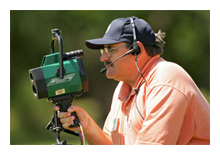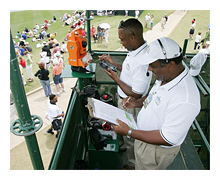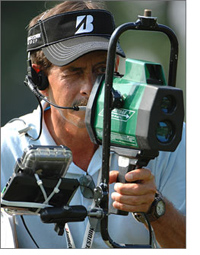Here at MSR we have been entranced this year with an app on the PGA Tour website called Shot Tracker. On the surface it looks just like an online leaderboard — until you glance at it while a tournament is going on, and you see all kinds of little graphics going in motion. Only then do you realize that hey — this thing is showing every shot on the course! — and if you are like me you are instantly addicted, watching seven different scores at once, to see how Tiger did out of the rough, how Phil did out of the trap, and whether Jason Day made that 40-foot, 4-inch putt.
Naturally, we wanted to know how it all worked so we put in a call to the PGA and eventually got on the horn with Steve Evans, a senior vice president in the PGA’s information systems department. Evans was kind enough to walk us through the amazing behind-the-scenes technology of Shot Link and Shot Tracker, both of which will likely play a huge role as the tour embraces more mobile data consumption options for its stats-insatiable fans.The key to understanding Shot Tracker is to know about Shot Link, the system that is the heart and soul of instant PGA statistics. Shot Tracker, which is an app on the PGA’s website, gets all its data from Shot Link, the system set up on each course. On the Shot Link site the PGA describes the system thusly:
According to Evans the two technological keys to Shot Link are wireless handheld devices for entering data about shots, and laser-based survey equipment, which as you might guess provides an accurate distance from laser to a golf ball lying in the grass. With every group of golfers in a PGA Tour event covered by Shot Link there is one person walking with the group as a scorer, entering information like “shot hit” when someone swings at a ball. On each hole there are also handheld and tower-located laser stations, to get fixes on balls in the fairways, rough, sand, and on the green.The ShotLink System is a revolutionary platform for collecting and disseminating scoring and statistical data on every shot by every player in real-time. The vision of the system is to “Turn data into information, information into knowledge, and knowledge into entertainment.”
The final piece to the Shot Link system is a huge graphical database of every course the PGA plays on, mapped for distances. Via triangulation from their laser stations and some sophisticated computer programs the Shot Link system can almost instantly calculate distances to greens, hazards and other places on their map — which the tour can then relay to commentators in the broadcast booths, making them seem like complete wizards of distance. But it turns out, there’s a lot of elves running around making the wizards look good.
Wireless Networks, and Lots of Volunteers
In addition to some impressive techno-firepower — Evans said the PGA has three different Shot Track setups that leapfrog each other going from venue to venue, with computer servers and office space in separate 53-foot trailers — at each venue the tour must draft up to 350 volunteers to staff the scoring system. When you start thinking about two-person crews for each tower laser, with one tower on par-3 holes, two on par-4s and three on par-5s, plus walking scorers, plus walking laser holders, plus several shifts to cover all the golfers at a tourney — the volunteer needs add up. But Evans said the drafting is actually getting easier each year.
“We have about an 80 percent retention rate” of volunteers signing up year after year, Evans said.
 The PGA also installs its own wireless network on each site, using approximately 22 access points, putting antennas up in the air a bit so that there is good coverage for all the handheld scoring devices and the lasers. Evans said the PGA also has sophisticated enough software to check for data anomalies, and if a question comes up the answer can be confirmed if necessary via a voice radio.
The PGA also installs its own wireless network on each site, using approximately 22 access points, putting antennas up in the air a bit so that there is good coverage for all the handheld scoring devices and the lasers. Evans said the PGA also has sophisticated enough software to check for data anomalies, and if a question comes up the answer can be confirmed if necessary via a voice radio.
What you have, in the end, is some incredible real-time data gathering being used to fuel stats and graphics that help bring the game to life, both in information relayed to TV broadcast crews as well as delivered directly to fans via apps like Shot Tracker.
And it’s not just distances that Shot Link provides. At the recent FedEx St. Jude Classic, it seemed like a lot of guys were rinsing their shots into water hazards. So a query was run against Shot Link data, and sure enough it showed that over 9 years there were more balls hit in the water at the FedEx than at any other course. Now that’s turning knowledge into entertainment.
On the drawing board is a new version of Shot Tracker, the addictive app that uses Shot Link data to show where and how players are playing on a leaderboard. Since the current version was built using Adobe Flash technology, it can’t be easily shown on Apple iPhones and iPads, since those devices don’t support Flash programs.
“Our road map [for Shot Tracker] is multi-platform, with lots of talk about mobile devices,” Evans said. He also hinted there might be a different user interface, perhaps one more like the one recently used for the U.S. Open that showed different playing groups on a graphical map of the course. That app, however, didn’t show shot by shot data, the killer app thing that Shot Link brings to the table.
As wireless electronics get better and cheaper, who knows what the future will bring — perhaps wireless microchips in each ball? For now, Shot Link and Shot Tracker are pretty darn good, and for that we can thank the PGA IT folks and the many, many volunteers who push the buttons and sight the lasers.
“It’s been kind of neat, to figure out how to build something like Shot Link,” Evans said. Golf fans everywhere, no doubt, agree.









